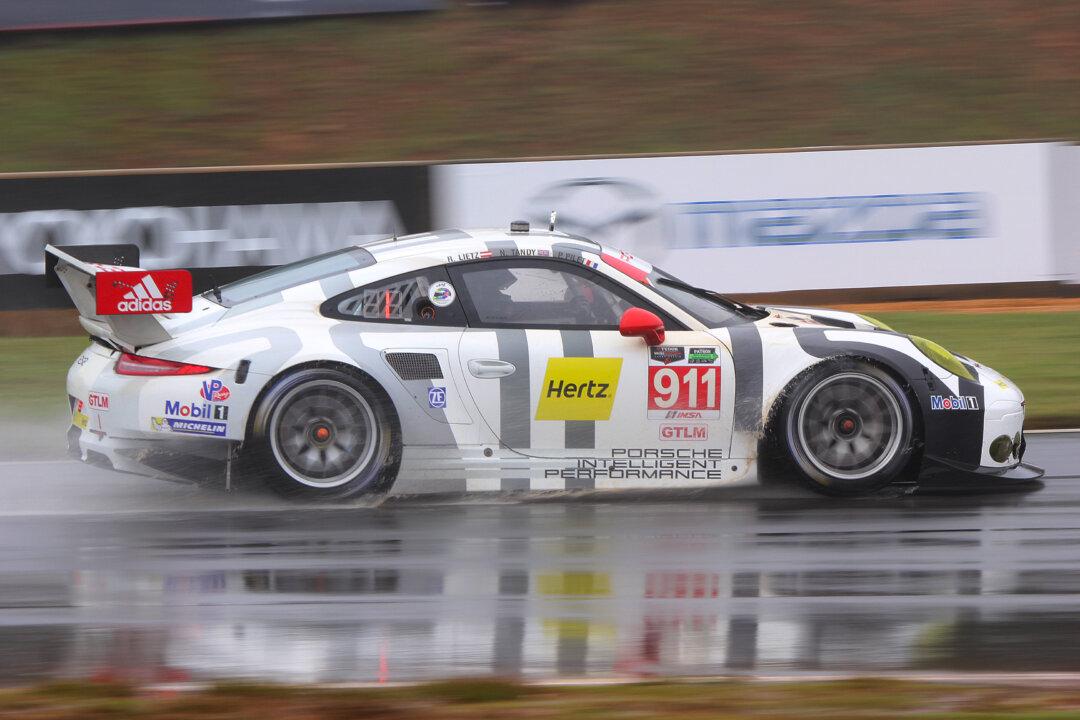BRASELTON, Ga.—After eight rain-lashed hours of racing, the checkered flag waved to end Petit Le Mans, the Tudor United SportsCar Championship season finale. Leading the field through the final laps was not one of the ultra-aerodynamic, high-powered, high-tech Prototypes, but the GT Le Mans-class #911 Porsche North America RSR—a car about as powerful and as highly developed as any of the prototypes but usually relegated to the middle of the grid.
The slickness of the rain-soaked track negated the aerodynamic advantage of the prototypes, giving the GT Le Mans cars a chance to compete on even footing—and compete they did. Both Porsches and both of the Corvettes led the race overall at various times, and when race director Beaux Barfield decided that the constant rain and gathering gloom made further racing unacceptably unsafe, it was the #911 Porsche driven by Patrick Pilet, Richard Lietz, and Le Mans winner Nick Tandy who led the pack.
In a statement later Tandy said, “The last stint when the rain became heavier was the toughest that I’ve ever driven in my career. To win the big and the petite Le Mans means a great deal to me. It’s every driver’s dream.”
The overall win gave Porsche the Manufacturer and Team titles in GTLM, and earned Patrick Pilet the Drivers title.
Third overall and first of the Prototypes, the #5 Action Express Coyote-Corvette sealed the Prototype class season title for the second consecutive year for drivers Joao Barbosa, Sebastien Bourdais, and Christian Fittipaldi. The #5 AXR car also won the Tequila Patrón North American Endurance Cup.
The #52 PR1-Mathiesen Oreca-Chevrolet won the Prototype Challenge class. The #73 Park Place Porsche 911 GT America finished first in GT Daytona.
Half the race, which was scheduled for ten hours, was run under yellow flag, and was red-flagged for an hour due to dangerous track conditions caused by the constant rain. The race restarted at 7 p.m. because the rain let up briefly, but the rain re-intensified, the radar picture showed no sign of respite, and the track lights and headlights couldn’t pierce the mist. “ I felt like I'd be putting drivers out there completely blind,” Barfield told Sportscar365.com.
Race director Beaux Barfield had to choose between running for two hours under yellow, even then risking wrecks as the conditions were so bad, or ending the race early before a disaster happened. Barfield chose safety, and the checkered flag waved at 8 p.m.
First GT Race Win Over Prototypes
Porsche’s GTLM victory marked the first time in the history of the Tudor series (and the second time this century) that a top-tier North American sports car race was won by a GT car. Normally, the purpose built prototypes have a huge edge over the GT cars, which are modified production cars—quick cars, to be sure: Porsches, Corvettes, Ferraris, Aston Martins—but still, street cars with wings and wide tires.






